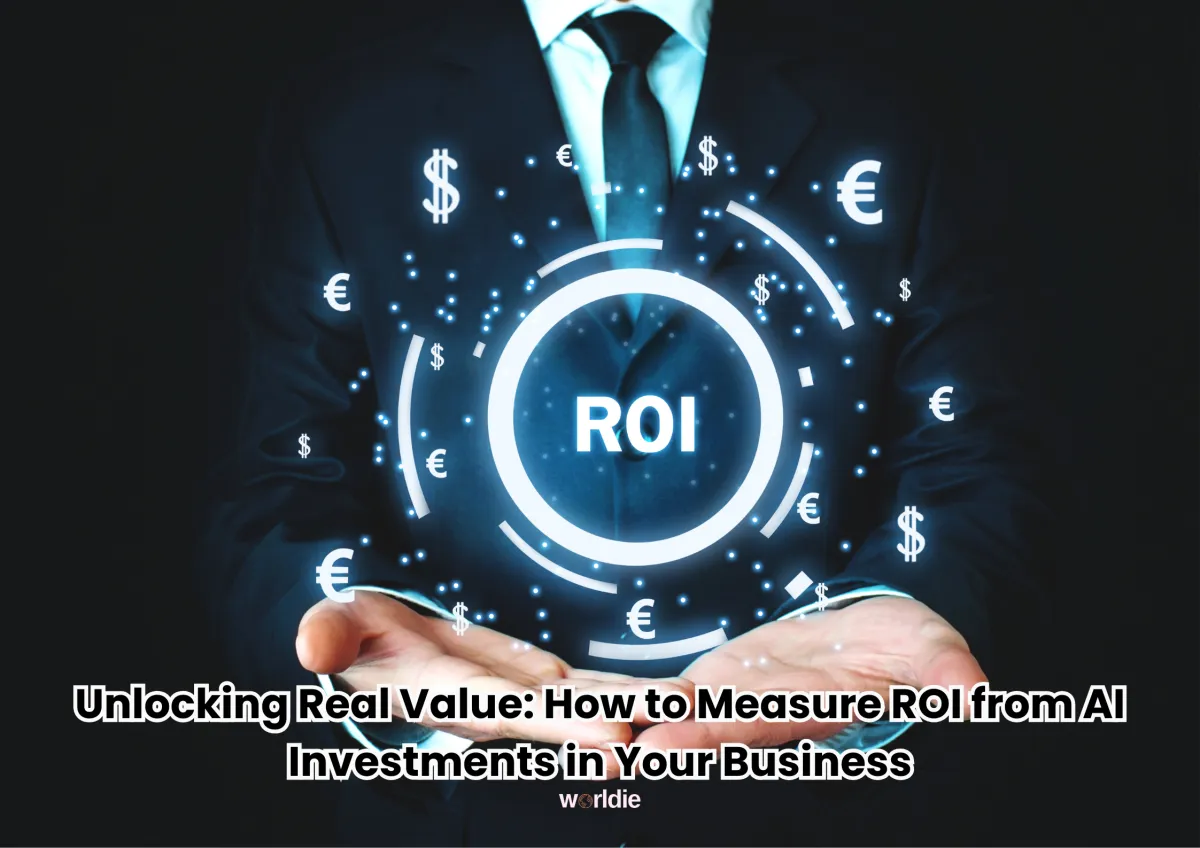
Unlocking Real Value: How to Measure ROI from AI Investments in Your Business
Artificial intelligence has become a core driver of competitive advantage and revenue transformation. But for many business leaders, the biggest question isn’t whether to adopt AI—it’s how to measure ROI from AI investments in your business. Measuring AI’s financial impact can be complex because its value extends beyond direct cost savings or productivity gains. It includes strategic outcomes such as faster decision-making, improved customer experience, and entirely new revenue streams.
For organizations serious about scaling AI adoption, understanding how to quantify its real-world return is a strategic imperative. This guide explores how to assess ROI from AI initiatives, what metrics matter most, and how Worldie AI helps businesses design, build, and deploy AI systems that directly link technology investments to measurable growth.
Understanding the True Meaning of ROI in AI
Traditional ROI metrics focus on straightforward calculations—profit gained versus money spent. In the context of AI, this formula expands. The value of AI includes automation efficiency, decision accuracy, innovation acceleration, and predictive intelligence. A system that reduces manual data processing time by 60% or cuts operational errors by 40% contributes to both direct savings and compounding business value.
The key is to align AI outcomes with strategic business goals. ROI must be viewed not just as financial return but as an index of impact—how AI improves customer retention, shortens sales cycles, or drives smarter allocation of resources.
The Business Inefficiencies AI Eliminates
Before calculating returns, leaders need to recognize the inefficiencies AI targets. Many businesses suffer from disconnected data systems, repetitive manual tasks, and delayed decision-making. These inefficiencies accumulate into operational drag that limits growth.
AI addresses these challenges by transforming how organizations operate. Predictive models anticipate customer demand, natural language systems automate support, and intelligent analytics reveal trends invisible to human analysis. These aren’t just cost-cutting tools—they’re systems that reshape how teams perform and compete.
Where AI Creates Tangible and Intangible Returns
The return from AI can be direct or strategic. Direct ROI often appears as reduced costs, improved margins, or increased throughput. Strategic ROI reflects brand equity, faster innovation, and better decision confidence.
For instance, a manufacturing firm might deploy AI to predict equipment failures before they occur, cutting downtime by half. A retail company might use recommendation algorithms that lift average order value by 15%. Over time, these seemingly incremental gains compound into exponential growth across departments.
Key Metrics to Measure AI ROI
To accurately evaluate performance, ROI tracking should blend financial and operational metrics. Key indicators include:
Cost savings: Reduction in manual labor, waste, and time-intensive tasks.
Revenue growth: New product lines or improved sales through personalization and predictive targeting.
Process acceleration: Shorter cycle times for production, marketing, or sales.
Customer satisfaction: Measured through engagement metrics or retention rates.
Decision quality: Accuracy of forecasts and insights generated by AI models.
Worldie AI builds data frameworks that monitor these metrics continuously, giving executives a live view of AI’s contribution to business performance.
How to Set a Baseline Before AI Implementation
Measuring ROI effectively requires a pre-AI baseline. This means quantifying current process performance, time spent, costs incurred, and output quality before AI deployment. With this benchmark in place, organizations can track percentage improvements once the system is operational.
Without a baseline, it’s easy to underestimate AI’s impact or misattribute outcomes to unrelated factors. Establishing these metrics early ensures leadership can justify continued investment and expansion.
The Worldie AI Approach: Design → Build → Release
Worldie AI follows a structured roadmap to maximize measurable outcomes from AI initiatives.
The Design phase focuses on defining high-value use cases, aligning with strategic goals, and identifying measurable success indicators. During the Build stage, Worldie AI engineers and data scientists create tailored models, automate workflows, and integrate analytics dashboards that track performance in real time. Finally, in the Release phase, the team ensures scalability, governance, and measurable ROI through continuous optimization and executive reporting.
This process ensures every AI investment connects directly to financial and operational performance metrics.
Common Challenges in Measuring AI ROI
Organizations often face several obstacles when trying to quantify AI’s impact. Data fragmentation is one of the most common—when data is scattered across departments, AI can’t generate unified insights. Another is unclear ownership, where no team is accountable for monitoring performance post-deployment.
There’s also the cultural challenge: employees may not fully trust or adopt AI-driven decisions, which can limit its real impact. Worldie AI addresses these challenges through integration frameworks, data alignment strategies, and employee training programs that build confidence in automation outcomes.
Building a Realistic AI ROI Model
The most reliable AI ROI models combine both tangible and strategic indicators. Start by projecting the potential efficiency gains or revenue uplift based on pilot data. Then, incorporate risk adjustments to account for system downtime, model drift, or data quality issues.
A mature ROI model should forecast benefits over 12 to 36 months, not just immediately after deployment. AI value compounds over time, especially as systems learn and adapt.
Quantifying Time-to-Value
ROI is only meaningful if leaders understand the time it takes for benefits to materialize. Some AI projects deliver visible impact in weeks, while others—like predictive maintenance or intelligent automation—may take months to reach maturity.
Tracking time-to-value allows leaders to evaluate how quickly investments translate into outcomes. It also helps allocate resources toward projects with the fastest measurable payback.
Real-World AI ROI Transformations
Consider an enterprise logistics company that deployed AI to optimize delivery routes. Within six months, route efficiency improved by 20%, cutting fuel costs and driver overtime. Or a SaaS platform that integrated an AI recommendation engine and saw a 35% increase in customer lifetime value.
These outcomes reflect the kind of scalable, measurable transformations Worldie AI enables. By connecting every AI capability to a defined business KPI, companies can trace real-world ROI without guesswork.
AI and Revenue Transformation
AI doesn’t just make processes faster—it changes how businesses generate revenue. Predictive analytics open new markets, AI-driven personalization increases conversion rates, and intelligent automation scales operations without linear headcount growth.
Worldie AI structures its solutions around this principle: every AI system must accelerate revenue creation while reducing friction. By aligning technology with business goals, companies don’t just gain ROI—they redefine it.
How to Communicate AI ROI to Stakeholders
Executives and investors care about evidence. ROI reports should combine quantitative data (cost savings, margin improvement) with qualitative proof (better customer experience, faster innovation cycles).
Visualization plays a key role. Worldie AI builds reporting dashboards that track ROI metrics dynamically, helping leadership teams present progress to boards and investors in ways that are clear and credible.
Building Long-Term AI ROI Culture
True ROI doesn’t stop after deployment. It evolves as the system learns, scales, and integrates deeper into business operations. Organizations that treat AI as an ongoing capability rather than a one-time project consistently see higher cumulative returns.
Worldie AI supports this with continuous improvement programs—monitoring data health, retraining models, and expanding automation coverage as the business grows.
Key Takeaways for Measuring ROI
Start with a clear baseline before implementation
Align ROI metrics with strategic objectives, not just costs
Track both direct financial outcomes and secondary performance gains
Adopt tools that visualize ROI for transparent stakeholder communication
Treat ROI measurement as a living system, not a one-off exercise
FAQs About Measuring ROI from AI Investments
1. What is the most accurate way to measure ROI from AI investments in your business?
The most accurate way is to link every AI initiative to measurable business KPIs—such as revenue growth, cost reduction, or time saved—while comparing those metrics to pre-deployment baselines.
2. How long does it take to see measurable ROI from AI?
Time-to-value varies by use case. Automation tools may deliver results in a few weeks, while predictive analytics or generative AI systems can take several months as data models mature.
3. Can small and medium businesses measure AI ROI effectively?
Yes. Even smaller organizations can track AI ROI through efficiency metrics, customer satisfaction scores, or conversion improvements. The key is setting measurable, realistic benchmarks early.
4. What challenges can distort AI ROI measurement?
Common distortions include inconsistent data, lack of adoption, and poor tracking frameworks. Without integrated analytics, it’s easy to misjudge impact or overlook hidden gains.
5. How does Worldie AI help ensure measurable ROI?
Worldie AI designs every project around measurable success indicators, integrates analytics dashboards to monitor outcomes in real time, and continuously optimizes system performance to ensure ROI is sustained and visible.

